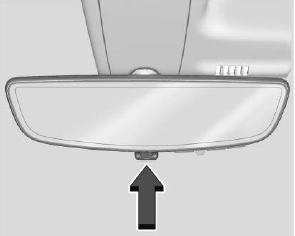Chevrolet Silverado: Towing the Vehicle / Recreational Vehicle Towing
Recreational vehicle towing means towing the vehicle behind another vehicle, such as a motor home. The two most common types of recreational vehicle towing are dinghy and dolly towing. Dinghy towing is towing the vehicle with all four wheels on the ground. Dolly towing is towing the vehicle with two wheels on the ground and two wheels on a dolly.
Here are some important things to consider before recreational vehicle towing:
- Before towing the vehicle, become familiar with the local laws that apply to recreational vehicle towing. These laws may vary by region.
- The towing capacity of the towing vehicle. Read the tow vehicle manufacturer's recommendations.
- How far the vehicle can be towed. Some vehicles have restrictions on how far and how long the vehicle can be towed.
- Whether the vehicle has the proper towing equipment. See your dealer or trailering professional for additional advice and equipment recommendations.
- Whether the vehicle is ready to be towed. Just as preparing the vehicle for a long trip, make sure the vehicle is prepared to be towed.
Follow the tow vehicle manufacturer’s instructions.
Caution
Use of a shield mounted in front of the vehicle grille could restrict airflow and cause damage to the transmission. The repairs would not be covered by the vehicle warranty. If using a shield, only use one that attaches to the towing vehicle.
Dinghy Towing (Two-Wheel-Drive Vehicles and Vehicles with a Single-Speed Transfer Case)
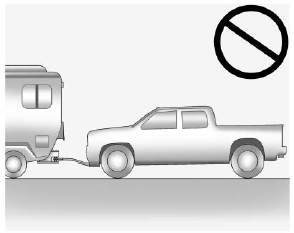
Caution
If a vehicle with two-wheel drive or a single-speed transfer case is towed with all four wheels on the ground, the drivetrain components could be damaged. The repairs would not be covered by the vehicle warranty.
Two-wheel-drive vehicles and vehicles with a single-speed transfer case should not be towed with all four wheels on the ground.
Dinghy Towing (Vehicles with a Two-Speed Transfer Case)
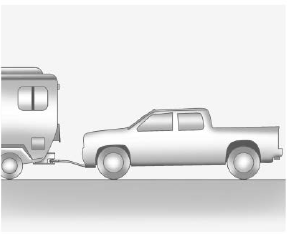
Only dinghy tow four-wheel-drive vehicles with a two-speed transfer case that
have an N (Neutral) and a 4  (Four-Wheel
Drive Low) setting.
(Four-Wheel
Drive Low) setting.
Warning
Shifting a four-wheel-drive vehicle's transfer case into N (Neutral) can allow the vehicle to move even if the transmission is in P (Park). You or others could be injured. Set the parking brake and use wheel blocks before shifting the transfer case to N (Neutral).
To dinghy tow:
- Position the vehicle being towed behind the tow vehicle, facing forward and on a level surface.
- Securely attach the vehicle being towed to the tow vehicle.
- Start the engine.
- Shift the transfer case to N (Neutral). See “Shifting into N (Neutral)” under Four-Wheel Drive.
- With the engine running, release the parking brake and verify that the transfer case is in N (Neutral) by shifting the transmission to D (Drive) and then to R (Reverse). There should be no movement while shifting the transmission.
- Shift the transmission to D (Drive).
- If equipped with an ignition key, turn the ignition to ACC/ACCESSORY. If
equipped with Keyless Access, turn the engine off. Disregard the Shift to P
(Park) DIC message. See Ignition Positions (Keyless Access) or Ignition Positions
(Key Access).
Warning
To avoid death, serious injury, or property damage, before dinghy towing the vehicle, always disconnect and secure the negative battery cable and cover the negative battery post and cable with a non-conductive material. If the battery is left connected or the battery cable contacts the post, the Electric Parking Brake may activate during towing, which could cause a crash.
- Disconnect the negative (–) battery cable. See “Negative Battery Cable Disconnection” in Battery - North America.
- Shift the transmission to P (Park).
Caution
If the steering column is locked, vehicle damage may occur.
- Move the steering wheel to make sure the steering column is unlocked.
- If the vehicle has an ignition key, keep it in the towed vehicle in ACC/ACCESSORY to prevent the steering column from locking. If the vehicle is equipped with Keyless Access, keep the RKE transmitter outside of the vehicle and manually lock the doors. Access the vehicle by using the key in the door lock. See Door Locks.
Disconnecting the Towed Vehicle
Before disconnecting from the tow vehicle:
- Park on a level surface. Secure the vehicle with wheel blocks.
- Re-connect the negative (–) battery. See Battery - North America.
- Turn on the ignition with the engine off. For vehicles with a key, turn the ignition to ON/RUN with the engine off. If the vehicle is equipped with Keyless Access, with your foot off the brake pedal, press and hold ENGINE START/STOP for five seconds until the green light comes on in the button. See Ignition Positions (Keyless Access) or Ignition Positions (Key Access).
- Set the parking brake. See Electric Parking Brake.
- Disconnect from the tow vehicle.
- Shift the transmission to N (Neutral).
- Shift the transfer case to 2
 (Two-Wheel Drive High). When the shift to 2
(Two-Wheel Drive High). When the shift to 2
 (Two-Wheel Drive High) is complete,
the light in the instrument cluster will stop flashing and stay lit. See Four-Wheel-Drive
Light.
(Two-Wheel Drive High) is complete,
the light in the instrument cluster will stop flashing and stay lit. See Four-Wheel-Drive
Light. - Start the engine. Check that the vehicle is in 2
 (Two-Wheel Drive High) by starting
the engine and shifting the transmission to D (Drive) and then to R (Reverse).
There should be movement of the vehicle while shifting.
(Two-Wheel Drive High) by starting
the engine and shifting the transmission to D (Drive) and then to R (Reverse).
There should be movement of the vehicle while shifting. - Shift the transmission to P (Park) and turn off the ignition.
- Release the parking brake and remove the wheel blocks.
- Reset any lost presets. The outside temperature display will default to 0 °C (32 °F) but will reset with normal usage.
Dolly Towing
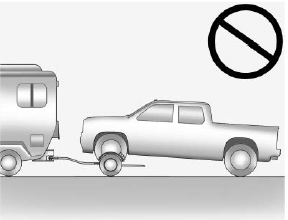
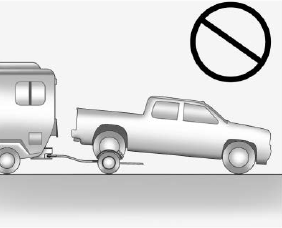
Caution
Do not tow this vehicle with two wheels on the ground, or vehicle damage could occur. This damage would not be covered by the vehicle warranty.
Dolly towing this vehicle is not allowed with either the front or the rear tires on the ground for two-wheel drive or four-wheel drive, regardless of transfer case.
 Towing the Vehicle
Towing the Vehicle
Caution
Incorrectly towing a disabled vehicle may cause damage. The damage would
not be covered by the vehicle warranty. Do not lash or hook to suspension components...
Other information:
Chevrolet Silverado 2019-2025 Owners Manual: Extended Parking
It is best not to park with the vehicle running. If the vehicle is left running, be sure it will not move and there is adequate ventilation. See Shifting Into Park and Engine Exhaust. If the vehicle is left parked and running with the RKE transmitter outside the vehicle, it will continue to run for up to half an hour...
Chevrolet Silverado 2019-2025 Owners Manual: Wiper Blade Replacement
Windshield wiper blades should be replaced periodically. See Maintenance Schedule. Replacement blades come in different types and are removed in different ways. For proper type and length, see Maintenance Replacement Parts. Caution Allowing the wiper arm to touch the windshield when no wiper blade is installed could damage the windshield...
Categories
- Manuals Home
- 4th Generation Silverado Owners Manual
- 4th Generation Silverado Service Manual
- Programming Transmitters to the Vehicle
- Universal Remote System Programming
- Engine Compartment Fuse Block
- New on site
- Most important about car
Rear Camera Mirror
If equipped, this automatic dimming mirror provides a wide angle camera view of the area behind the vehicle.
